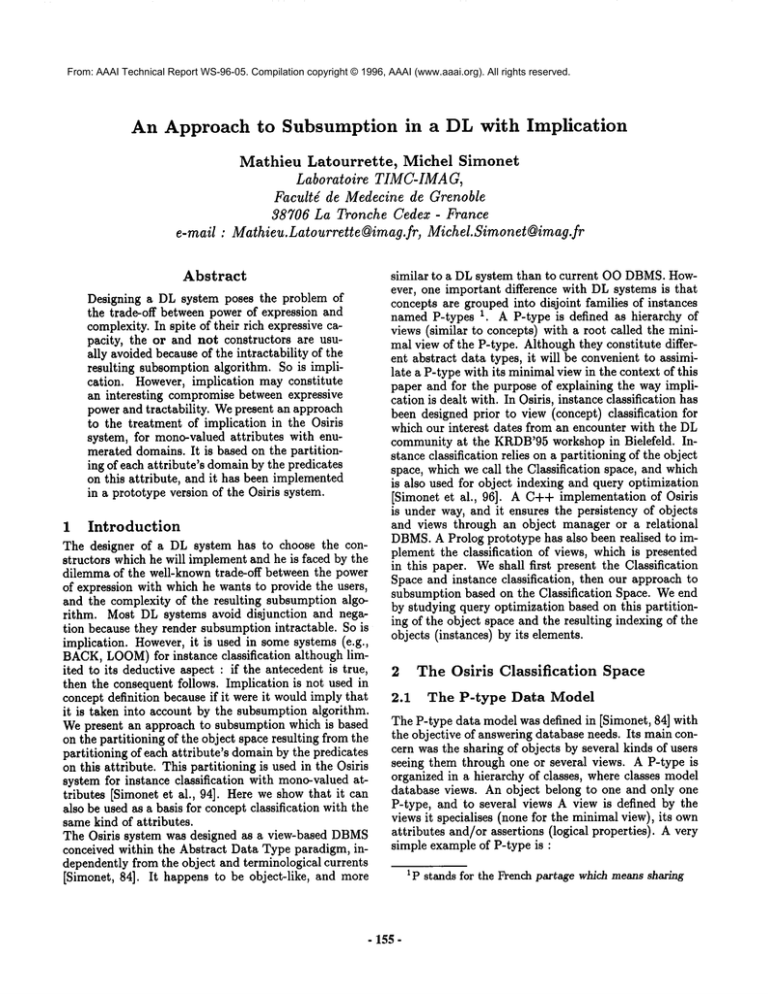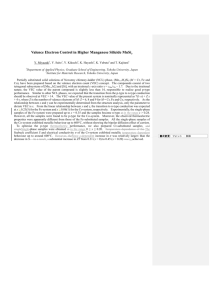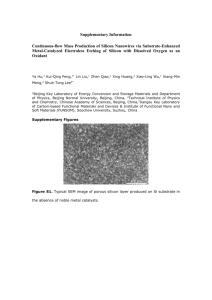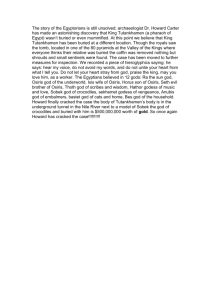
From: AAAI Technical Report WS-96-05. Compilation copyright © 1996, AAAI (www.aaai.org). All rights reserved.
An Approach to Subsumption in a DL with Implication
Mathieu
e-mail
Latourrette,
Michel
Simonet
Laboratoire
TIMC-IMA G,
Facultd de Medecine de Grenoble
38706 La Tronche Cedex - France
: Mathieu.Latourrette@imag.fr,
Michel.Simonet@imag.fr
Abstract
Designing a DL system poses the problem of
the trade-off between power of expression and
complexity. In spite of their rich expressive capacity, the or and not constructors are usually avoided because of the intractability of the
resulting subsomption algorithm. So is implication. However, implication may constitute
an interesting compromise between expressive
power and tractability.
Wepresent an approach
to the treatment of implication in the Osiris
system, for mono-valued attributes with enumerated domains. It is based on the partitioning of each attribute’s domainby the predicates
on this attribute, and it has been implemented
in a prototype version of the Osiris system.
similar to a DL system than to current OODBMS.However, one important difference with DLsystems is that
concepts are grouped into disjoint families of instances
named P-types 1. A P-type is defined as hierarchy of
views (similar to concepts) with a root called the minimal view of the P-type. Although they constitute different abstract data types, it will be convenient to assimilate a P-type with its minimal view in the context of this
paper and for the purpose of explaining the way implication is dealt with. In Osiris, instance classification has
been designed prior to view (concept) classification for
which our interest dates from an encounter with the DL
community at the KRDB’95workshop in Bielefeld. Instance classification relies on a partitioning of the object
space, which we call the Classification space, and which
is also used for object indexing and query optimization
[Simonet et al., 96]. A C++ implementation of Osiris
is under way, and it ensures the persistency of objects
and views through an object manager or a relational
DBMS.A Prolog prototype has also been realised to implement the classification of views, which is presented
in this paper. Weshall first present the Classification
Space and instance classification,
then our approach to
subsumption based on the Classification Space. Weend
by studying query optimization based on this partitioning of the object space and the resulting indexing of the
objects (instances) by its elements.
1
Introduction
The designer of a DL system has to choose the constructors which he will implementand he is faced by the
dilemma of the well-known trade-off between the power
of expression with which he wants to provide the users,
and the complexity of the resulting subsumption algorithm. Most DL systems avoid disjunction and negation because they render subsumption intractable. So is
implication. However, it is used in some systems (e.g.,
BACK,LOOM)for instance classification
although limited to its deductive aspect : if the antecedent is true,
The Osiris
Classification
Space
2
then the consequent follows. Implication is not used in
concept definition because if it were it would imply that
The P-type
Data Model
2.1
it is taken into account by the subsumption algorithm.
The P-type data model was defined in [Simonet, 84] with
Wepresent an approach to subsumption which is based
the objective of answering database needs. Its main conon the partitioning of the object space resulting from the
cern was the sharing of objects by several kinds of users
partitioning of each attribute’s domainby the predicates
seeing them through one or several views. A P-type is
on this attribute. This partitioning is used in the Osiris
organized in a hierarchy of classes, where classes model
system for instance classification with mono-valuedatdatabase views. An object belong to one and only one
tributes [Simonet et al., 94]. Here we show that it can
P-type, and to several views A view is defined by the
also be used as a basis for concept classification with the
views it specialises (none for the minimal view), its own
same kind of attributes.
The Osiris system was designed as a view-based DBMS attributes and/or assertions (logical properties). A very
simple example of P-type is :
conceived within the Abstract Data Type paradigm, independently from the object and terminological currents
1p stands for the French partage wh/ch means shar/ng
[Simonet, 84]. It happens to be object-like, and more
- 155-
view PERSON
attributes
Name : STRING,
Age: [0..150],
Sex : {M, F},
MilitaryService : {no, done, ongoing, deferred}
assertions
Sex : F -+ MilitaryService : no
Age < 18 --+ MilitaryService : no
Age _> 18 and Sex : M -~
MilitaryService : {done,ongoing,deferred)
view MINOR : PERSON
attributes
Age: [0..17]
view SENIOR : PERSON
attributes
Age: [65..150]
The logical properties which define the views use Domain Predicates, e.g., predicates of the form:
Attribute E Domain,
where the considered domains are of enumerated types.
The assertions are Horn clauses where the literals are Domain Predicates. The minimal view of a P-type can be
considered as a primitive concept while the other views
of the P-type are defined concepts. Osiris can be considered as a subset
of a DL withtheconstructors
:
all R C, someR, and,domain,range,and --+.
TheaboveP-type
definition
is equivalent
to thefollowingterminological
definitions
written
in BACK:
Name := domain (PERSON) and range(STRING)
type feature
Age := domain (PERSON)and range(J0..150])
type feature
Sex := domain( PERSON) and range(
type feature
{M, F}
the P-type PERSON
that it is neither a VEHICLEnor a
MUSHROOM
nor a DISEASE, which constitute
distinct
and disjoint P-types. This way of partitioning the modelled universe into disjoint subsets may seem awkwardto
DLpeople. In fact, this partitioning of the universe into
disjoint P-types is not necessary at the modelling level
but is useful (maybe necessary) to provide an efficient
support for persistency. P-types are the implementation
units for persistency, as can be seen in the relational
implementation of Osiris [Quast et al., 95].
The relationships
between two P-types are of two
kinds : composition and inheritance. Composition allows the type of an attribute to be another P-type (or
view of a P-type, e.g., Possesses : VEHICLE),and inheritance expresses that a P-type inherits some properties
of another P-type, which is not presented here.
The Classification
Space
2.2
The Classification Space of a P-type is defined as the
quotient space of the object space of the P-type relative to the equivalence relation : to have the same truth
values for all the DomainPredicates occurring in the
assertions of the views of the P-type.
For a given predicate, e.g., Age > 18, this relation
leads to a partitioning of its attribute domain into two
elements : its extension ([18..150]), and its complement
(]0..18[). The product of all the partitions [Stanat, 77]
generated by all the DomainPredicates on a given attribute, e.g., Age, defines a partition of the domain of
this attribute, and its elements are called Stable SubDomains(SSD). In effect, if the value of an attribute
changes while remaining in the same SSD, all the predicates on this attribute keep the same truth value : true
or false. The SSDsof the attribute Age are :
d11=[0..17], d12=[18..64], d13=[65..150].
Similarly, the attribute Sex is partitioned into :
d21={F}, d22={M},
and the attribute MilitaryService into :
d31={done, ongoing, deferred}, d32={no).
MS
MS := domain(PERSON) and range({no,
type feature
done,...))
PERSON:< some( Name ) and some( Age
and some( Sex ) and some( MS)
some(Age,[0..17]) --+
all( MS, no )and
some(Sex, F) ~ all(MS, no)
some(Age, [18..150])and some( Sex, M)
Ml(MS,{done, ongoing, deferred})
[0.17]
[18_64]
[65_150]
MINOR:= PERSONand all(Age, [0..17]
SENIOR:= PERSONand all(Age, [65..150] )
Another important difference between P-types and DLs
is that P-types represent disjoint sets of objects. Therefore it is not necessary to indicate in the definition of
Figure 1: Classification
Space of a P-type : PERSON
Prolonging this partitioning to the object space gives
the Classification Space, whose elements are called Eq-
- 156-
classes. The Classification Space can be represented by
hypercubes, each representing an Eq-class (Fig. 1).
Because of its size, which is exponential to the number of attributes, the Classification Space is never represented in its totality, but it underlies the classification
processes.
Classifying an instance consists in determining its
views. In Osiris, it suffices to determine its Eq-class because each eq-class can be associated with the views of
the P-type whose elements belong to it. Associating an
eq-class with its views is not done once for all at compile
time, but is performed for a given Eq-class the first time
an instance which belongs to it is entered in the base.
Only the Eq-classes containing at least an object are effectively created and they are used to index the objects
of the base. This partitioning of the objects presents
many similarities with that obtained by the horizontal
fragmentation algorithm of [Ozsu et al., 91].
3
Subsumption
A view can be characterized as a set of eq-classes. Let
Eq~ be the set of eq-classes belonging to the view Vi.
Eqi is not built explicitly. Wehave chosen to represent
a view by two components :
¯ a filter F which limits the domain validity of the
view. For a view V~ it is a superset of Eqi, which is
built from the definition domains of the attributes
of Vi.
¯ a set C (for Complement)of tuples of attribute domains corresponding to the areas which are falsified
by at least one assertion.
This choice of representing the complement of the
valid part of the Classification Space instead of the valid
part itself follows the study of [Bassolet et al., 96]. Both
components F and C are Cartesian products of attribute
domains. The minimal view PERSON
is represented by:
The Eq-class space associated with the instance John
is defined as Fj/Cj, which represents the symmetric difference between the sets Fj and Cj. This gives :
{ [0..17] x {M}x {no} },
which implies that John is less than 18.
The subsumption relationship
V1 < V2 expresses
that the view V1 is subsumedby the view V2, i.e.,
V1 C V2, or Eql C Eq2. This is equivalent to :
((C2 [7 FI) (J (FI/F2))cCI
Verifying this formula is equivalent to checking that a
set of cubes is included in another set of cubes, which
is a NP-complete problem. However, when views are
defined only by domain restrictions (no assertions), the
process is polynomial, because there, is only one cube
per set. The general method to check that E1 C E2
consists in verifying for each element of E1 that it is included in E2. This approach can be extended to domain
predicates of the form Attribute E View, e.g., Child :
MINOR.However, we have not taken into account this
form in the antecedent of an implication because this
would lead to the complexity problems of the not operator. The presented method has been implemented in a
Prolog prototype of Osiris. This prototype supports the
propagation of object modification, which is not the case
of the ongoing C++ implementation whose aim is more
database-oriented.
4
Fp = [0..17] x {M,F} x {no, done, ongoing, deferred}
Cp -- { [0..150] x {F} x {done, ongoing, deferred},
[0..17] x {M,F}x {done, ongoing, deferred},
[18..1501 x {M}x {no}
The view MINOR
is represented by :
Fm=[0..17] x {M,F} x {no, done, ongoing, deferred}
Cm={[0..17] x {M,F} x {done, ongoing, deferred}}
and the view SENIORby :
Fs = [65..150] x {M,F} x {no, done, ongoing, deferred}
Cs = {[65..150] x {F} x {done, ongoing, deferred},
[65..150] x {M}x {no}}
For a given view, each element of C is obtained as the
intersection of F with the complemen$of an assertion.
For example, in the minimal view PERSON,the first
tuple of Cp represents the area falsifying the assertion
Sex : F -~ MilitaryService : no.
An instance is represented in the same manner. For example, the instance defined as :
John :: PERSONand all(MS, no) and all(Sex,
is represented by :
Fj = [0..150] x {M}x {no}
and the assertions Cp of the minimal view.
Restricting Cp to the space Fj gives :
Cj = {[18..150] x {M} x {no}}
Query Optimization
The partitioning of the object space into Eq-classes is
the basis of the implementation of the Osiris system.
Althoughthe Classification Space is never represented in
its totality, it underlies the whole Osiris implementation.
The actual objects of the base are indexed by a structure
containing their Eq-class and the corresponding views.
This leads to an optimization of query evaluation based
on the semantic properties of the views.
Osiris queries are of the form (Context [ condition)
where the Context part is expressed by a propositional
formula ~(Vi) on the views of a P-type. The Condition
part expresses a logical condition on the attributes of
the P-type and has the same form as the general Osiris
assertions.
A query is rewritten in terms of SSDs and the corresponding elementary predicates. It may be labeled,
thus defining a dynamic view (as opposed to the ’static’
views which constitute the P-type). However, contrary
to static views, dynamic views are not materialized and
- 157-
the objects contained in a dynamic view have to be reevaluated every time the view is invoked.
Indexing by Eq-classes enables the system to determine which Eq-classes are valid, invalid, and potential
as regards the query. For example, the query
QI: ( PERSONI Age _< 40 )
divides the Classification Space into three sets of Eqclasses :
Eq,~ = (dll, *,*) : the persons aged under 18 satisfy
the query.
Eq~ = (d13, *,*) : the persons aged over 65 do not
satisfy the query.
Eqp = (d12, *,*) : the persons whose age has to
checked.
The objects indexed by invalid Eq-classes (Eq~) are
automatically rejected and those indexed by valid Eqclasses (Eq~) are part of the answer. Only the objects
indexed by potential Eq-classes (Eqp) have to be checked
individually. Nowconsider the query :
Q2 : (person I Age > 40 and Income > 10 000).
The sets of objects to consider are represented in Fig.
2, reduced to the two dimensions Age (dli) and Income
(d4j). A couple of values V, I, or P is associated to each
Eq-class, indicating its validity relative to the literals
PI: Age > 40 and P2: Income > 10000 repectively.
d41
d42
1000-6000 6000-9500
dll
I
Age~l! I
d12
I’
18.~ge,~
d13
Age~65
I
I
d43
9500
d44
9500-25000
d45
>25000
I
I
I
P
I
P
v I
y
I
V I
I
is straightforward through the indexing structure.
In [Buchheit et al., 94], the authors give the conditions necessary to perform semantic query optimization,
based on class, view and query classification relative to
subsumption. They propose a ’maximal’ set of operators which keeps subsumption polynomial. However,
in the object model which they consider, which is the
’standard’ object model for databases, the views must be
persistent and automatically maintained, i.e., the sets of
objects which they designate must be modified when the
database is updated. However,view materialization still
remains an open problem in databases, even relational.
The ’object-preserving’ condition defined by [Scholl et
al., 91] is also implicit, because views are subsets of objects instanciated in classes and therefore do not create
new objects.
Semantic query optimization consists in keeping the
result of queries as persistent views and then classifying any new query relative to these views. The most
specialized view represents the most restricted set of objects within which the query can be evaluated without
loss of information. This approach shows the interest of
reasoning on an intensional definition of views (or concepts), which is the basis of DL. The same approach
underlies the view approaches of [Scholl et al., 91] and
[Rundensteiner, 92], although it is less developed.
In Osiris, a query is evaluated within a given P-type.
It is not classified explicitly relative to the other (static)
views of the P-type. However,as it is rewritten in terms
of the SSDsof the attributes which it contains, it would
be possible to classify it. Wethink this would not be
useful because we have a more refined indexing of objects
through the Eq-classes.
5
Figure 2: Analysis of the Classification
query Q2
Conclusion
Space of the
The Eq-class (d13,d45) is valid, and so are the objects
which are indexed by it. The Eq-classes which are invalid
for at least one predicate are excluded from the answer,
and the objects of those which contain a V and a P
must be checked individually. However, the test may be
refined; for example, it is sufficient to check (d13, d44)
for P2 and (d12, d45) for P1.
A dynamic view, defined by a query, can be made
static, i.e., integrated to the definition of the P-type.
This is a particular case of schema modification, which
may lead to refine the SSDpartitioning for certain attributes occurring in the Condition of the query. For example, Q1 would refine d12 into [18,40] and [41,64]. Only
the objects belonging to the indexing structures containing a modified Eq-class have to be classified again and
assigned to their new Eq-class. The benefit is that the
view which has been madestatic is materialized, i.e., automatically maintained, and the access to their elements
The P-type data model was conceived as a database
model, where the grouping of classes into disjoint families is natural. It is also indicated in [Buchheit et al.,
94] as a condition which is necessary to perform query
optimization in object databases by using subsumption.
Such grouping can be considered as a way to provide a
DLwith a higher level of structuring, while it is almost
necessary in a database perspective. However, it leads
to some limitations, which will be overcomein Osiris by
introducing the inheritance of properties in the Abstract
Data Type sense.
Concept classification
was not an initial aim of the
Osiris system, where instance classification remains the
main objective [Bassolet et al., 96] , and where query
optimization is obtained through the indexing of objects
by subsets of the Classification Space. However,concept
(view) classification provides a higher level of static integrity checking and therefore will be introduced in the
ongoing system written in C++, following the approach
presented in this paper.
- 158-
6
Bibliography
[Baasolet et al., 96]: C.-G. Bassolet, A. Simonet, M.
Simonet, Probabilistic Classification in Osiris, a Viewbased 00 DBMS and KBMS, DEXA96, 7th International DEXAWorkshop on Database and Expert Systems Applications, Zurich, Sept. 1996.
[Buchheit et al., 94]: M. Buchheit, M. A. Jeusfeld,
W. Nutt, M. Staudt, Subsumption between queries to
object-oriented database, Information Systems 19(1):3354, 1994.
[Ozsu et al., 91]: M. T. Ozsu, P. Valduriez, Distributed
Database Design : Fragmentation (Chap. 5.3), in Principles of Distributed Database Design, Prentice Hall, 1991
[Quast et al., 95]: M. Quast, A. Simonet, M. Simonet, A Relational Implementation of a View-based
Object System, OOIS’95 (Object-Oriented Information
Systems), J. Murphyand B. Stone eds, Dublin, pp. 111117, Dec. 1995.
[Rundensteiner, 92]: E. Rundensteiner, Multi View: A
Methodology for Supporting Multiple Views in ObjectOriented Databases, Proc. of the 18th VLDBConference, Vancouver, Canada, 1992.
[Simonet, 84]: A. Sales-Simonet, Types Abstraits et
Bases de Donndes: formalisation du concept de partage
et analyse statique de contraintes d’intdgritd- Th~se
Doeteur Ing~nieur, Universit~ Scientifique et M~dicale
de Grenoble, France, Avril 1984.
[Simonet et al., 94]: A. Simonet, M. Simonet, Objects
with Views and Constraints : from Databases to Knowledge bases, OOIS’94 (Object-Oriented Information Systems), London Dec. 1994, Springer Verlag, pp 182-197.
[Simonet et al., 96]: A. Simonet, M. Simonet, Classement d’instance et Evaluation des Requites en Osiris, in
BDA’96: Bases de Donn~es Avanc~es, Cassis, France,
Aofit 1996.
[Scholl et al., 91]: M. H. Scholl, C. Laasch, M. Tresch,
Updatable Views in Object-Oriented Databases, Proc.
2nd DOODconf., pp 187-198, Dec. 1991
[Stanat et al., 77]: D. Stanat, D. McAllister, Discrete
Mathematics in Computer Science, Prentice Hall, 1977.
- 159-





